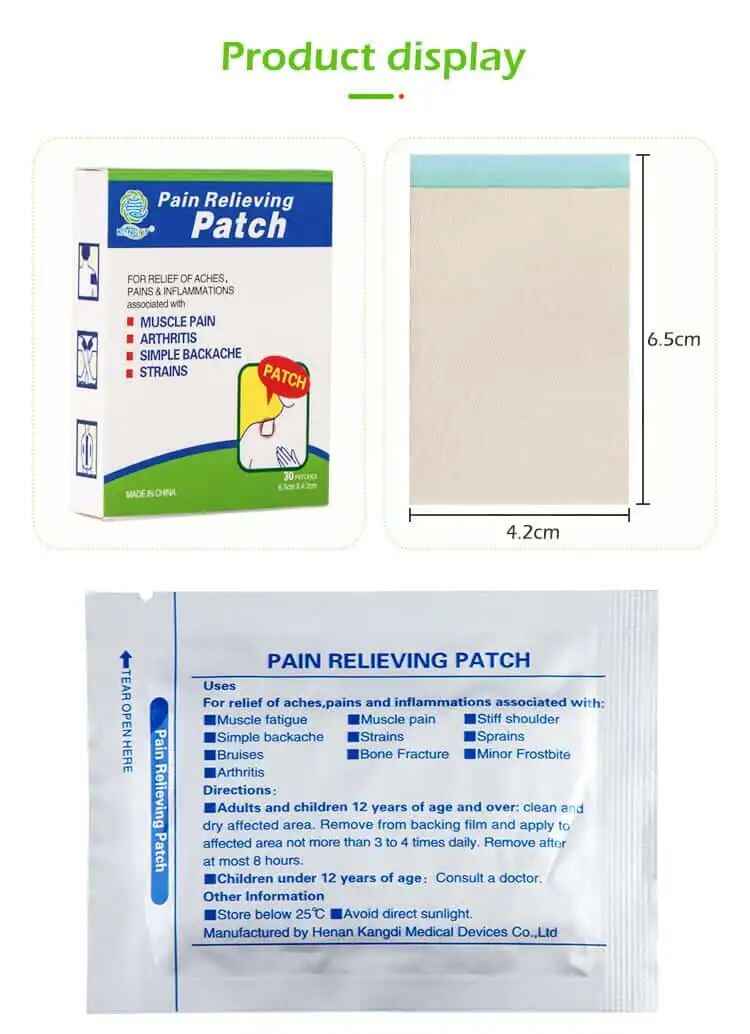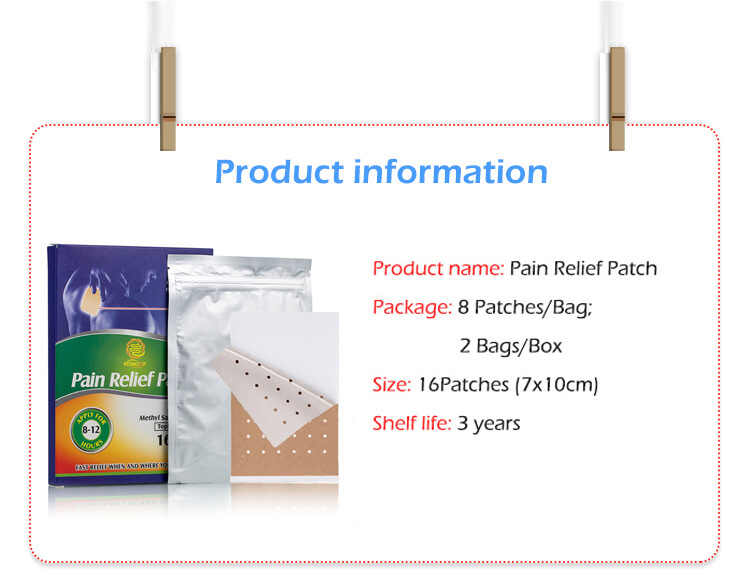The Science Behind Effective Pain Relief Patches: What B2B Buyers Need to Know
In the booming wellness and pharmaceutical industries, Effective Pain Relief Patches are revolutionizing how individuals manage pain. For B2B buyers, understanding the scientific foundation of these patches is crucial when selecting an Effective Pain Relief Patches Manufacturer, negotiating with an Effective Pain Relief Patches OEM, or launching a Private Label Effective Pain Relief Patches line.
This comprehensive guide will explore the technology, ingredients, delivery mechanisms, and what sets an Effective Pain Relief Patches Supplier apart in today's competitive market.

1. Understanding the Technology Behind Effective Pain Relief Patches
1.1 Transdermal Drug Delivery System (TDDS)
The foundation of effective pain relief patches lies in Transdermal Drug Delivery Systems (TDDS). This technology allows for the steady absorption of pain-relieving compounds through the skin directly into the bloodstream.
1.2 Advantages of TDDS:
Sustained release: Ensures prolonged pain relief.
Bypass first-pass metabolism: More efficient than oral medications.
Fewer gastrointestinal side effects: Ideal for patients with sensitive digestive systems.
This science is what Effective Pain Relief Patches Manufacturers prioritize when designing and testing their formulations.
2. Key Ingredients in Effective Pain Relief Patches
The composition of the patch is what determines its efficacy. High-quality Custom Effective Pain Relief Patches typically contain the following types of ingredients:
2.1 Active Ingredients
Menthol: Provides cooling, anti-inflammatory effects.
Capsaicin: Reduces substance P in the body, diminishing pain signals.
Lidocaine: Numbs the area and blocks nerve signals.
Methyl Salicylate: Delivers a warming sensation that relieves muscle tension.
2.2 Enhancers and Stabilizers
Hydrogel: Commonly used for moisture retention and comfort.
Microneedle technology: In advanced patches to boost absorption.
Natural extracts: Like arnica, turmeric, or camphor, included by many Private Label Effective Pain Relief Patches brands for market differentiation.
B2B buyers should partner with an Effective Pain Relief Patches OEM that can customize ingredient profiles to meet specific regulatory, cultural, or marketing needs.
3. Types of Pain Relief Patches and Their Applications
3.1 Over-the-Counter (OTC) Patches
These are widely available and used for general aches, muscle stiffness, and mild to moderate joint pain. An Effective Pain Relief Patches Supplier typically offers these for bulk purchase and retail distribution.
3.2 Prescription Patches
Used for chronic conditions or post-operative pain, these contain stronger compounds like opioids or NSAIDs and must comply with stricter regulations.
3.3 Custom Formulations
Custom Effective Pain Relief Patches are designed for niche markets:
Athletes (with cooling or anti-inflammatory features)
Seniors (with gentler, natural formulations)
Medical spas (with herbal extracts)
A reliable Effective Pain Relief Patches Manufacturer will offer R&D services to develop these niche products.
4. What to Look for in an Effective Pain Relief Patches Manufacturer
4.1 Certifications and Compliance
Reputable manufacturers will hold certifications such as:
GMP (Good Manufacturing Practices)
ISO 13485 (Medical device standards)
FDA or CE approvals depending on markets
4.2 Customization Capabilities
If you're aiming for Private Label Effective Pain Relief Patches, your supplier should offer flexibility in:
Ingredients
Patch sizes and shapes
Packaging designs
Branding elements
4.3 Scalability and Lead Time
Fast-growing brands need a manufacturer who can scale production while maintaining quality. Choose an Effective Pain Relief Patches Supplier with global logistics capabilities and established lead time practices.
4.4 R&D and Innovation
An Effective Pain Relief Patches OEM partner should offer:
Access to clinical research
Support with testing and trials
Ability to adopt new technologies like nanotechnology or biodegradable patches
5. The Role of Private Labeling in Brand Differentiation
In a crowded market, Private Label Effective Pain Relief Patches allow B2B buyers to:
Control brand messaging
Cater to specific customer needs
Maximize profit margins
With a strategic Effective Pain Relief Patches OEM, businesses can rapidly bring unique and high-quality products to market without investing in manufacturing infrastructure.
5.1 Popular Private Label Strategies
Seasonal promotions (e.g., sports recovery patches)
Eco-friendly packaging
Natural or organic-only ingredients
Subscription-based product delivery
6. Quality Control and Testing: The Non-Negotiables
6.1 In-House Testing
Top Effective Pain Relief Patches Manufacturers run extensive testing on:
Adhesion
Drug release rate
Skin irritation potential
6.2 Third-Party Verification
To build trust, reputable Effective Pain Relief Patches Suppliers often partner with third-party labs to validate claims.
6.3 Regulatory Documentation
Buyers should request:
Certificates of Analysis (COA)
Material Safety Data Sheets (MSDS)
Clinical study summaries, if available
7. Trends Influencing the Pain Relief Patches Industry
Natural ingredients and clean labels
Biodegradable patches and sustainable packaging
AR/QR code-enabled packaging for consumer education
Global demand for personalized healthcare solutions
These trends are shaping the innovation roadmaps of every leading Effective Pain Relief Patches OEM.
Final Thoughts
For B2B buyers, success in the pain relief patch market hinges on a clear understanding of the science behind the product, coupled with the right manufacturing partnership. By working with a knowledgeable Effective Pain Relief Patches Manufacturer, engaging with a reliable Effective Pain Relief Patches OEM, or investing in Private Label Effective Pain Relief Patches, businesses can offer proven, high-quality pain relief solutions tailored to specific consumer needs.
The key is to prioritize technology, ingredient integrity, customization, and regulatory compliance at every step.
Related Questions and Answers
1. What makes a pain relief patch effective?
A pain relief patch is effective when it uses proven transdermal technology, contains clinically-backed ingredients, and delivers consistent therapeutic effects.
2. How can I customize Effective Pain Relief Patches for my brand?
Work with a Custom Effective Pain Relief Patches OEM who offers flexible ingredient sourcing, design options, and packaging personalization.
3. What regulations must Effective Pain Relief Patches meet?
Depending on the market, patches may require FDA approval (USA), CE marking (EU), or other certifications such as GMP and ISO.
4. Why is private labeling a smart option for B2B buyers?
Private Label Effective Pain Relief Patches offer high-margin opportunities, brand ownership, and customization without the need for manufacturing investment.
5. What should I ask an Effective Pain Relief Patches Supplier before signing a contract?
Ask about certifications, lead times, MOQs, customization options, and support for clinical testing or documentation.






